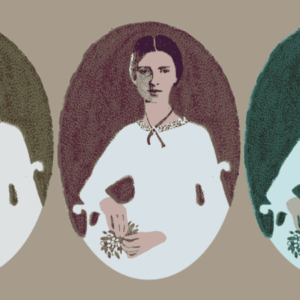
Protest Art and the Fight for Standing Rock
"Bursheim Had Sewn a Subtle but Still Quite Visible 'NOKXL' on the Back of the Quilt"
To write about blankets is to be lured to metaphor and cliché. Patchwork, weave, unravel, unfold, stitch. A blanket of snow. A blanket of stars. Blanket statement. Blanket policy. To pull the wool over one’s eyes. A wolf in sheep’s clothing. Good metaphors are rich with tension, precise yet expansive, lively because they provoke surprise—the reader or listener expected something different. The blanket is a pliable object, an unruly form until one folds it—into shape, into language. The blanket beckons our imagination, our capacity to narrate war and trauma, shootings and bombings, pleasure, birth, death, security, virality, rocks, copper, gypsum, marble, and concrete. The fabric of time—not just a nice metaphor—refers to making a plane. A fabrication can signify an invention or creation, as in a lie or deceit, or as in the construction of an object, often with metal and stone. Fabricate and fabric both derive from the Latin fabrica, which refers to art or craft, the manner of construction, or even skillful production. Fabrica is derived from faber, forger or smith. Like to forge, to fabricate has the double valence of creativity and deception. When magicians perform a trick, they might conceal the scene—a specific object, a table, or their own hand—with a blanket, a cover. The audience watches with anticipation as something underneath and out of sight transpires, and then transforms for the reveal, the magic. As covers, blankets keep our secrets and reserve our grief and pleasures. They are narrative ciphers. Mnemonic devices.
President Obama fulfilled his goal to visit all 50 states during his presidency when in May 2015, he traveled to South Dakota, the last state on his list, and delivered the commencement address to the Lake Area Technical Institute in Watertown. The school commissioned Dakota artist and citizen of the Sisseton-Wahpeton Oyate DeVon Bursheim to make a star quilt to present to Obama. Star quilts are cherished gifts to honor and protect the recipient on a journey: memorial feasts, celebrations, naming ceremonies, marriages, powwows, and basketball tournaments. The owíŋža (quilt) signifies recognition and respect, and it is made to be given away.
Most star quilts feature a single eight-sided star in the center, made up of small diamond-shaped patches conjoined in eight sections. The star pattern is reminiscent of early buffalo robe designs, and the quilt a distant echo of the robe—star quilts are the symbolic replacement of buffalo robes, according to Richard Peterson. The near-extermination of bison by settlers in the mid- to late 19th century coincided with the incarceration of Oceti Sakowin children in mission and boarding schools, where they learned quilting. While some textile histories attribute the quilt’s design to the “Variable Star” pattern used in mid-17th-century New England, according to Oceti Sakowin cosmology, the star represents the morning star, a guiding light.
“Star quilts are cherished gifts to honor and protect the recipient on a journey: memorial feasts, celebrations, naming ceremonies, marriages, powwows, and basketball tournaments.”
At the time of Obama’s visit, the Keystone XL (KXL) pipeline was awaiting his final approval. The $8 billion, 1,179- mile TransCanada pipeline would pass through Alberta, Saskatchewan, Montana, South Dakota, and Nebraska: homelands of the Blackfoot, Lakota, Dakota, Assiniboine, Ponca, Cree, and Dene peoples. And while much attention was given to the fight against KXL for the unlikely alliances it created, the tar sands, pipelines, fracking, and other forms of extractivism are not only “universal” issues, but specifically matters of Native/Indigenous/First Nations sovereignty and land rights.
Cree, Dene, and Métis communities have been on the front lines against the Alberta tar sands and TransCanada for years. In September 2010, the Assembly of First Nations of Canada asked the US government to account for the environmental impact of the tar sands, including the high rate of cancer downstream in the Fort Chipewyan community. The next year, the Mother Earth Accord, signed by the Oceti Sakowin and other tribal nations and organizations, was presented to President Obama at the 2011 White House Tribal Nations Conference. The document exhorts Obama and Secretary of State John Kerry to reject the permit for the KXL pipeline and to reduce reliance on oil, including the tar sands. The Mother Earth Accord also asserts that “Indigenous people are most vulnerable to the social, cultural, spiritual, and environmental impacts of climate change.”
As she handed her quilt to President Obama, DeVon Bursheim said, “Tasina Pezuta Win emakiyapi ye,” they call me blanket woman. Unbeknownst to the Lake Area Technical Institute and Obama staffers, Bursheim had sewn a subtle but still quite visible “NOKXL” on the back of the quilt. Bursheim prayed for her land and water in the giveaway. In November 2015, Obama rejected the permit for KXL. As Tom Goldtooth of the Indigenous Environmental Network put it, Obama’s rejection of the KXL helped Cree and Dene people at the source come one step closer to shutting down the tar sands and defeating the black snake. But just days after officially assuming the US presidency, Donald Trump signed executive actions to allow for the construction of KXL; and one week before Nebraska’s Public Service Commission was set to determine KXL’s specific route from Canada to Nebraska, TransCanada’s Keystone pipeline leaked well over 200,000 gallons (or 5,000 barrels) of oil in South Dakota. Most reports of the leak identified its location as being on “private land” near the small town of Amherst. But the oil also infiltrated the soil and ground water near the Lake Traverse Reservation, home of the Sisseton-Wahpeton Oyate.
Trump’s executive order in January 2017 also approved the completion of the Dakota Access Pipeline, owned by Houston-based Energy Transfer Partners: a $3.8 billion, 1,110-mile fracked-oil pipeline from the Bakken shale fields in North Dakota to Peoria, Illinois. The plans for the pipeline included nine major intersections between the pipeline and rivers in present-day North Dakota, South Dakota, and Iowa. The pipeline poses risks for multiple populations along its route, from spills and leaking that will occur to the introduction of invasive species, fungi, and microbes transported by drilling equipment. People who live on reservations proximate to the pipeline are disproportionately at risk, including citizens of the Standing Rock Sioux Tribe whose lands straddle present-day South and North Dakota.
In 2014, a year before his trip to South Dakota, President Obama visited the Standing Rock Sioux Nation—his first visit to a reservation as president, and the first-ever presidential visit to a North Dakota reservation. As a candidate in 2008, Obama had been adopted by the Crow Nation and given the name Barack Black Eagle, One Who Helps the People Across the Land, and his time at Standing Rock in 2014 gestured back to the promises and commitments he made to Indian Country when he was on the campaign trail: education reform, economic development, the “respect” of tribal sovereignty, and the recognition of tribal jurisdiction for major crimes. Standing Rock chairman Dave Archambault II and councilmember Frank Whitebull presented Obama with a red, white, and blue star quilt.
In April 2016, water protectors from the Oceti Sakowin founded the Sacred Stone Camp at the confluence of Mni Sose and the Cannonball River. Despite statements from the Standing Rock Sioux Tribe and the Tribal Historic Preservation Office that the completion of the Dakota Access Pipeline would damage historic preservation areas, the Army Corps of Engineers fast-tracked a permit to finish the construction, citing “no direct or indirect impacts.” By August, water protectors had established three additional camps and were deeply engaged in peaceful and prayerful protection of their relatives, human and nonhuman, threatened by the completion of the pipeline. At the main camp, Oceti Oyate, Native and non-Native water protectors and allies arrived daily with supplies, including blankets and food, to share. While the Obama administration remained at first silent, and later suggested they would let the situation “play out” for several more weeks, water protectors declared their determination to remain in camp and to stop the final construction of the pipeline. The final section to be completed would lurk within one mile of Standing Rock Sioux Tribe’s lands, across Mni Sose and under Lake Oahe—two significant water sources for the tribe and for millions of people downriver. Playing out included attack dogs, pepper spray, water cannons, concussion grenades, Blackwater surveillance tactics, helicopters, tanks, private security forces, North Dakota state police, police from neighboring states, arrests that sometimes took water protectors out of state without any method of contact with people who could free them from custody, elder abuse, the defamation of sacred bundles and inipi, and illegal construction.
“People who live on reservations proximate to the pipeline are disproportionately at risk, including citizens of the Standing Rock Sioux Tribe whose lands straddle present-day South and North Dakota.”
In September, and certainly in October and November, temperatures in North Dakota can dip below freezing at night. But water protectors were undeterred. With supplies, including blankets and cordwood, water protectors were prepared and emboldened to stay in camp, to keep fire, through the winter. While they endured floodlights, helicopters, and people sneaking into camp under cover (posing as allies, but later reporting lies to ignite highly flammable racism in Mandan and Bismarck), a monument called Dignity was dedicated at the Lewis and Clark rest area near Chamberlain, South Dakota, on the homelands of the Kul Wicasa Oyate, the Lower Brule Sioux. The 50- foot, 11-ton statue stands on a ridge above Mni Sose, downriver from Oceti Oyate and the other Standing Rock camps. Artist Laureate of South Dakota Dale Lamphere designed the figure to honor Lakota and Dakota people. He used three Native women models, ages 14, 29, and 55, to fabricate the face of the Native woman who stands with her arms outstretched, a star quilt across her back. The stars on the quilt are composed of more than 100 four-foot, blue, stainless steel diamonds that flutter when the wind passes through. A central stainless steel pipe bears the weight of the quilt “and the fabricated sculpture of the woman.” Her dress is patterned after a two-hide dress from the 1850s.
Proximity to the monument and its fluttering star quilt evokes a kind of awe at Lamphere’s design and engineering. But Dignity cannot bear the weight of colonial history, installed as it is at a rest area named for Lewis and Clark, who were sent on a trespass mission following the Louisiana Purchase, the largest real estate “deal” in US history. Nick Estes puts the Louisiana Purchase into context:
None of the Native Nations west of the Mississippi consented to the sale of their lands to a sovereign they neither recognized nor viewed as superior. It was only after we rebuffed Lewis and Clark for failing to pay tribute for their passage on our river [Mni Sose] that they labeled the Oceti Sakowin “the vilest miscreants of the savage race.” (“Fighting”)
Dignity was commissioned by a private citizen from Rapid City, a gift to “all the people of South Dakota,” on the occasion of the 125th anniversary of statehood. South Dakota became a state in November 1889—just months after Congress passed an act which yet again reduced the once-vast land base of the Oceti Sakowin, and divided the nation into smaller reservations, including Standing Rock, Pine Ridge, Cheyenne River, and Lower Brule. Although Dignity was offered as a monument to honor Lakota and Dakota people, its site on the upper banks of Mni Sose—not only a water source, but a relative to the Oceti Sakowin—reads more like degradation under cover. A pipeline, which defames Dakota—the term for friend or ally—was also commissioned along this river. It will leak, and its concrete shell will fail to shield Mni Sose and surrounding lands from the traumas of extractivism.
Dignity, cast and permanent, inadvertently honors an ongoing deception. But DeVon Bursheim’s “NOKXL” fulfills the form of the gift and exchange—the star quilt honors the recipient, and the message it bears honors the sovereignty, self-respect, and determination of Dakota and Lakota people. Like sovereignty, dignity is not something that can be gifted or bestowed.
__________________________________

From Blanket. Used with permission of Bloomsbury. Copyright © 2018 by Kara Thompson.
Kara Thompson
Kara Thompson is Assistant Professor of English and American Studies, College of William and Mary, USA. Her writing has appeared in the Los Angeles Review of Books, Avidly, and the Atlantic.



















